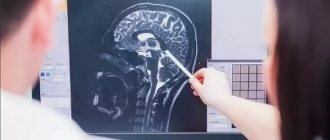Dyscirculatory encephalopathy (DEP) is a serious brain disease that affects blood vessels. As a result, some areas of the brain matter do not receive oxygen and nutrients.
This leads to oxygen starvation of the nervous tissue, swelling, dysfunction and destruction.
The disease develops due to the pathology of small and large vessels. Affects approximately 5–6% of the total population.
Most cases occur in older people, but are often found among the working population.
DEP grade 3 is a severe pathology in which brain functions are significantly impaired, leading to serious abnormalities.
Disease severity
Depending on the clinical manifestations, it is customary to distinguish three degrees of severity of this disease:
- 1st degree. In the initial stage of the disease, subjective sensations appear. The patient notes decreased performance, mood swings, sleep disturbances, decreased memory, and increased fatigue. In most cases, there are no objective signs.
- 2nd degree . It is characterized by more obvious manifestations of the disease. Neurological disorders are noted. Upon examination, a neurologist can detect deviations from the norm in the psychological and emotional sphere.
- 3rd degree . The last stage of DEP is characterized by serious neurological changes. The patient's mental state becomes unstable, there may be attacks of aggression, and coordination is impaired. In some patients, the functions of the visual and sensory systems are impaired. Mental abnormalities, lethargy, and periodic fainting are observed.
Prevention
The main goal of preventive measures for dyscirculatory encephalopathy is to eliminate the causes of deterioration in brain activity. Even from adolescence, it is necessary to pay attention to maintaining vascular health:
- observe the work and rest schedule;
- adhere to a special diet;
- take vitamin preparations for preventive purposes;
- perform gymnastic exercises;
- pay attention to physical fitness;
- regularly spend time in the fresh air;
resort to massage and physiotherapeutic procedures.
Features of stage 3
The development of vascular dementia is observed. All symptoms progress and become more pronounced.
Seizures similar to epileptic ones appear, and intelligence decreases.
A person becomes unable to care for himself; he requires constant attention and care. His fate depends entirely on those around him.
Urinary incontinence is observed, walking is impaired, and dementia develops. The patient loses the ability to learn new skills.
Ultimately, grade 3 dyscirculatory encephalopathy ends in disability, and in especially severe cases, death.
The transition from mild to severe forms can sometimes exceed 5 years, but there are cases when the stages of DEP change rapidly, in less than 2 years.
Symptoms of DEP grade 3
At the third stage, all symptoms worsen and new ones are added. If at first the deviations in the functioning of the nervous system are insignificant, then gradually they reach their apogee. The patient ceases to be aware of his condition and does not criticize actions. Grade 3 is characterized by an aggressive behavior. A person’s intellect is impaired, persistent dementia develops, i.e. dementia. The patient is able to work for some time.
Symptoms expressed:
- severe dementia;
- urinary incontinence;
- movement disorder;
- speech disorders.
The main symptom is severe dementia
How does dementia manifest? This is a dysfunction of the intellect, in which the ability to comprehend the connection between events and phenomena surrounding a person is reduced. Cognition processes become worse, emotional reactions and character traits become poorer, some of them disappear. The patient ceases to distinguish between the important and the unimportant. A person does not notice such problems; they greatly affect relatives. In severe cases of dementia, a person loses speech skills and becomes incapacitated.
Usually the patient is given a disability. The most unfavorable course is observed against the background of diabetes mellitus. With grade 3 DEP, complications arise that further aggravate the situation.
What are the causes of the disease?
Discirculatory encephalopathy develops due to the pathology of the capillaries, as a result of which they cannot fully supply the brain matter with nutrients and oxygen.
This happens for the following reasons:
- Hypertension causes damage to the integrity of blood vessels. They overlap and burst, causing brain matter to absorb plasma or blood. Harmful substances can also enter when the walls of blood vessels lose elasticity.
- Hypotension . The capillaries are weakly filled with blood, it slowly flows through them.
- In atherosclerosis, cholesterol plaques clog blood vessels. Due to improper metabolism, fats accumulate on the walls, gradually the lumen decreases and is completely blocked. Under such conditions, blood does not reach all parts of the brain.
- Osteochondrosis of one of the spine sections. With this pathology, the brain receives less blood than it should due to compression by spasmed muscles and bone processes of the vertebral artery.
- Impaired blood circulation can be caused by increased blood viscosity, which causes platelets to stick together and form clots or thrombi. They block the vessel, and the part of the brain that it supplied gradually dies.
- Nicotine addiction leads to a decrease in the lumen of capillaries, this is especially pronounced in the brain. With prolonged smoking, this condition becomes irreversible.
- Pathology of blood vessels and blood reduces the speed of movement of the latter throughout the body. Such diseases include thrombophlebitis and vegetative-vascular dystonia.
- Disturbances in the functioning of blood vessels are observed with congenital anomalies (pathological development of veins and arteries, angiodysplasia).
- Hematomas formed due to injuries to the brain or spine. They put pressure on the capillaries, compress them, and impair the access of oxygen and nutrients to the nerve cells.
- Hormonal imbalance . Endocrine glands produce hormones that regulate the state of the lumens of blood vessels in the brain. With their pathology, the production of hormones is disrupted. A hormonal imbalance often causes the development of dyscirculatory encephalopathy in women during menopause.
The transition of the disease to stage 3 is facilitated by stress, emotional stress, smoking, alcoholism, and osteochondrosis of the cervical spine.
You can study what autonomic dysfunction is and how it manifests itself in our article.
Inability to coordinate movements, spinocerebellar ataxia - features of symptoms and treatment of the disorder.
Reasons for development
The main etiofactor is insufficient blood supply caused by pathological changes in blood vessels. In 60% of cases, DEP is provoked by cerebral atherosclerosis. The second place in prevalence is occupied by increased blood pressure due to hypertension and secondary hypertension due to kidney damage, Itsenko-Cushing's disease, and pheochromocytoma.
Other causes include vertebral artery syndrome, cerebral vascular anomalies, cervical osteochondrosis, spinal injuries, arrhythmias, vasculitis, arterial hypotension and TBI. Diabetes mellitus, complicated by diabetic macroangiopathy, is often cited as the main or complicating factor.
Previously, encephalopathy of discirculatory (vascular) origin was traditionally considered as a disease of the elderly. Now the situation has changed. Heart diseases have become “younger”, which has led to an increase in the frequency of early manifestations of DEP. Experts point out that currently the pathology is often detected in people under 40 years of age.
When systemic metabolic disorders are added, they speak of discirculatory dismetabolic encephalopathy of complex (mixed) origin. This option is more typical for representatives of older age groups.
How does the disease manifest itself?
Stage 3 DEP is characterized by serious impairment of vital functions.
The patient experiences severe headaches, tinnitus, disturbed sleep, sudden mood swings, increased fatigue, and a significant decrease in performance.
Such changes occur due to damage to the subcortex of the brain, where information centers are located. They control sleep and are responsible for the functioning of the body’s sensory systems (hearing, vision).
When the integrity of the capillaries is disrupted, a microstroke develops. As a result, the mental center suffers.
It becomes difficult for the patient to focus on specific things, memory decreases, and it is difficult for him to imagine the final result of his actions.
If the medulla of the frontal lobe is affected, emotional instability, depression, indifference, attacks of aggression, hysterics, and apathy are noted.
The process of transmitting information from nerve cells to organs is disrupted.
It becomes difficult for the patient to coordinate movements, walking changes, it becomes unsteady. On examination, the tendons and muscles are in spasm.
The patient loses the ability to perform the simplest tasks of self-care.
He needs care, the constant presence of a person who will help him.
When the occipital lobe is damaged, vision is affected. Sometimes symptoms of oral automatism are observed: a nasal voice, opening of the mouth when some part of the body is irritated, difficulty swallowing.
Development mechanism
Insufficient blood supply to the brain leads to deterioration of nutrition, hypoxia and death of nerve cells, which means the formation of numerous “silent infarctions” and areas of rarefaction of cerebral tissue. The most affected are the subcortical structures and white matter, located at the border between areas, the blood supply of which is carried out from different large arteries.
The predominant localization of the lesion explains the “disconnection phenomenon” - the loss of connections between cortical and subcortical structures. In the early stages of the disease, functional changes occur, which are reversible with timely initiation of adequate therapy. Subsequently, persistent disorders develop, often leading to disability. In half of the patients, encephalopathy of the dyscirculatory type is complicated by degenerative processes, which makes its course more severe.
Treatment approach
The goal of therapeutic measures is to treat the underlying pathology, eliminate lesions and restore brain function, protecting it from oxygen starvation.
Treatment of grade 3 dyscirculatory encephalopathy is complex.
To eliminate the pathology and restore the condition of the brain cells, you need to strictly follow all the recommendations.
A diet with limited salt and fat is prescribed. The use of vitamins is mandatory.
It is important to engage in psychotherapy.
The patient will recover more easily if he is occupied with certain tasks that he can perform. This approach will help him realize that there is a chance for recovery.
Drug treatment
Several drugs are prescribed at once to ensure normal blood flow, restore nerve cells and eliminate the cause.
The following drugs are used:
- Lisinopril is a drug to lower blood pressure if hypertension has led to the development of DEP.
- Acetylsalicylic acid (aspirin) – thins the blood, prevents platelets from sticking together and blocking blood vessels.
- Curantil - helps to increase the lumen of capillaries, strengthens their walls.
- Nimodipine - blocks the supply of calcium to the muscles, which leads to their relaxation and improved blood flow. As a result, movements improve and the ability to think sensibly is restored.
- Atenolol - removes excess fluid from the body, normalizes heart function, increases blood flow, reduces heart rate and blood pressure.
- Vasobral - protects brain cells from oxygen starvation, prevents the formation of blood clots, improves metabolic processes in the subcortex, and restores functions.
- Ginseng tincture is a natural remedy. It helps increase productivity, improves brain function, cardiovascular system, reduces the amount of cholesterol in the blood, and fights increased fatigue. However, the use of ginseng tincture for hypertension is contraindicated.
Physiotherapeutic methods are also used in the treatment of grade 3 DEP: electric sleep, massage, galvanotherapy, baths, laser and UHF therapy.
Surgery
This method is used if drug treatment does not give the desired results. Surgery is performed on the great vessels.
Diagnostics
Early diagnosis is of great importance for long-term ability to work and a high quality of life, so older people should undergo periodic examinations by a specialist in the field of neurology. Tests are used to detect minor cognitive dysfunction. The examination program includes the following procedures:
- examination by an ophthalmologist, determination of visual fields, ophthalmoscopy;
- echoencephalography, electroencephalography, rheoencephalography;
- Dopplerography and duplex of head and neck vessels, magnetic resonance angiography.
Differential diagnosis with other pathologies involves MRI. To clarify the reasons, an examination by a cardiologist is prescribed; according to indications, consultations with a nephrologist and endocrinologist are carried out. The list of laboratory tests includes a coagulogram, determination of glucose, lipoproteins and cholesterol. If arrhythmia is suspected, electrocardiography and daily ECG monitoring are indicated.
Clinical signs of the disease
The main symptoms of dyscirculatory encephalopathy appear already at stage 2 of the disease. The patient has neurological manifestations, mental changes, and emotional instability. At the last stage of the pathology, vascular changes are already irreversible, they are actively progressing, and the clinical picture is becoming brighter.
Characteristic signs of DEP grade 3:
- conflict, irritability, aggressiveness;
- deterioration of perception, problems with hearing and vision;
- problems with coordination, unsteady and shuffling gait, slow movements, small steps;
- apathy, lack of interest in affairs or others, indifference, inadequate reaction to what is happening;
- slurred speech, change in voice;
- decreased mental abilities, inability to solve the simplest intellectual problems;
- inability to control natural processes - urinary incontinence, problems with swallowing food;
- memory impairment, loss of ability to read and write;
- tremor of the limbs, paresis, paralysis, epileptic seizures.
If a patient is diagnosed with stage 3 DEP, this automatically means disability. Such a person is unable to lead a normal lifestyle, engage in work or ordinary daily activities. It is noteworthy that these patients themselves do not realize that they have problems and do not complain about changes in the body.
How long can you live
The prognosis for stage 3 dyscirculatory encephalopathy is unfavorable. The patient may live several years after diagnosis, but even then he will remain in a frail state. In the case of elderly patients, there is a high probability of developing a number of dangerous complications. They often cause death.
Possible consequences of stage 3 DEP:
- stroke - acute cerebrovascular accident;
Find out more about stroke here.
- cardiovascular collapse is heart failure, which results from a decrease in vascular tone. The condition is accompanied by a decrease in the volume of circulating blood, due to which the heart ceases to receive nutrition in the required volume;
- heart attack – necrosis of heart tissue as a result of insufficient blood supply.
Hypertensive and mixed forms of DEP may be accompanied by hypertensive crises. These emergencies are also life-threatening and can lead to death at any time.









